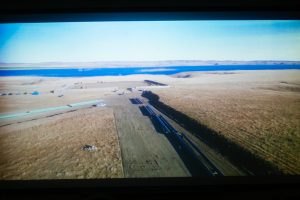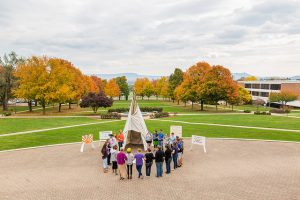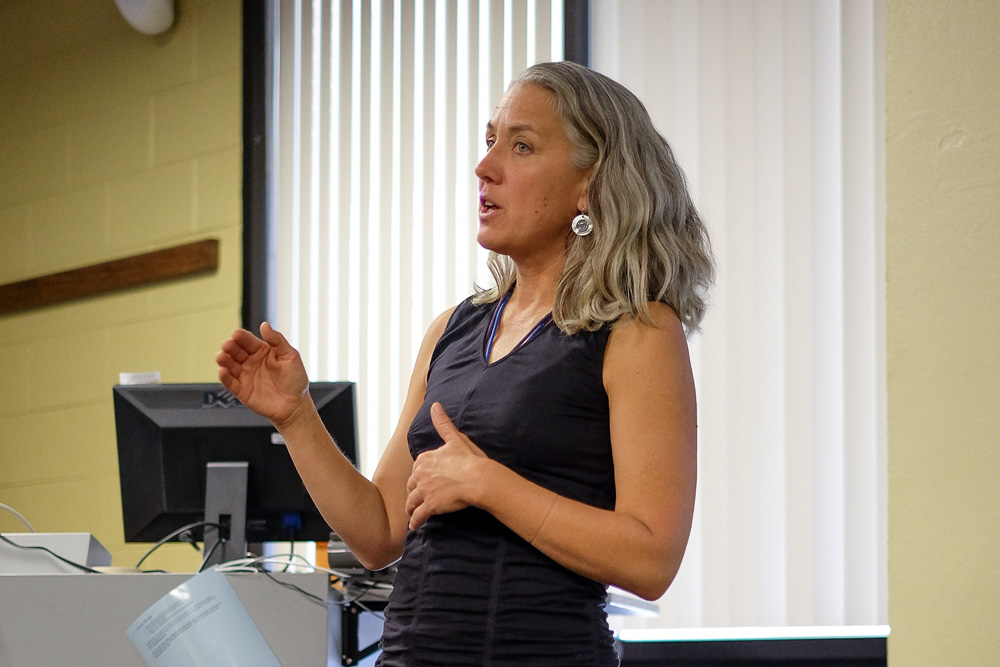It’s Paulette, coming live to you from Cannonball, North Dakota, and I’m at the sacred defenders’, the Water Defenders’ camp. And it’s early-early. I’m just waiting for the sun to come up. I’m so grateful to be here.
Thus began a Facebook live video on Sept. 7 from Paulette Moore, former visual and communication arts professor at Eastern Mennonite University (EMU), now filmmaker-in-residence with the Kanatsiohareke Mohawk Community of Fonda, New York.
Moore recently visited EMU to tell her story of transformation from a debt- and material-heavy, D.C. reporter to a university professor, and now, a mobile, indigenous-focused “story doula.” Most recently, she has helped birth the stories of the “Water Protectors,” as civic activists opposing the Dakota Access Pipeline call themselves.

The pipeline is being built across Standing Rock Sioux sacred burial ground and under the Missouri River, their primary source of drinking water. Standing Rock’s resistance has attracted thousands of native and other supporters to North Dakota, as well as conflicts with armed police and the National Guard.
Moore has been active through Facebook Live and Vimeo covering direct actions, commentating and interviewing activists over the past two months. Her base is at Sacred Stone Camp, established last spring for prayer and direct action concerning the pipeline.
Moore’s work with Standing Rock is an appropriate step in her personal journey: embracing her own mixed heritage of Kanien’kehaka Mohawk and British, learning frugality and simple living in EMU’s Mennonite context, and trading what she found to be impersonal, traditional journalism for personal, invested storytelling.
In 2013, she began working on a documentary series with the Ojibwe people of Northern Wisconsin, opposing an open pit taconite mine. Moore’s 2014 documentary filmmaking class collaborated on the project, titled “To Wisconsin With Love.”
During her talk, Moore showed a video clip from the beginning of the Iraq war, in which she was a Westinghouse on Economic News correspondent reporting the market response to the U.S. bombings of Baghdad and Kuwait.
She then showed a Nov. 2 video interview of a Standing Rock Water Protector, Dean Deadman Jr., about the drone footage he captured of the pipeline’s progress after a four-day no-fly zone restriction was lifted. Moore invited the 30 people in attendance to contrast the two videos.
“The sacredness really stood out to me” in the second video, Professor Carolyn Stauffer said. In it, Deadman talked about the burial ground spirits disturbed by pipeline construction, and the psychological repercussions for those involved.

Moore went on to describe Native American philosophies of connectedness and respect, and how they manifest in her own methodology of filmmaking and at Standing Rock’s camps. Moore asks herself certain questions of each film project, such as, does the film create respect for humans and non-humans alike? Does it engage the four elements of human understanding – mind, body, emotion, and spirit? The camps operate by pooling and sharing resources.
After her talk, Stauffer led the room in a standing ovation to show solidarity for Moore’s work. Moore answered audience questions about what could be done in support of Standing Rock, and how the protests could succeed.
The key, she says, is not beating the U.S. government at their own game, but redefining success altogether. She referenced the Standing Rock camp’s example of interdependence, knowledge-sharing, and connection to their land and home-grown food.
“This is a hotbed” of similar initiatives, she said of Harrisonburg. Moore encouraged those unable to travel to North Dakota to “find ways to use your own skills where you are.” Sharing ideas, dismantling personal materialism, and building a new culture – that is the success, informed by indigenous values, that we must seek. She left the group with a gift: a tea blend for “anyone with a cold,” made of mullein leaves she personally foraged.

I would like to join the discussion. About month ago I began to pay attention via facebook live feeds etc. from Standing Rock. I have emerged as a baby journalist. I went out there for a week. back home now and posting on ‘indiancountryTV’. Have put aside my job as a professional artist and devoted myself to this movement. In most ways I am on my own with this commitment to post news – but recieved powerful support from Paulette as I really began my journey. I’ve come a long way in a short while. I need to stay connected to folks that are learning to help people become informed and people that know how to do it. I seem to be getting the help I need when I need it and thats a higher power / creator thing. So I’m saying here. I am with you and I will help in any way I can. Know that I’m here struggling some to do a good job with this new direction creator has placed in my path. Thx, Kathy Tenney
Beautifully written story about great work being done by Paulette! Thank you.